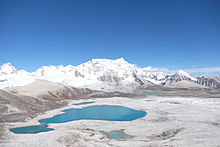Gangkhar Puensum (Dzongkha: གངས་དཀར་སྤུན་གསུམ་, romanized: Kangkar Punsum, alternatively, Gangkar Punsum or Gankar Punzum) is the highest mountain in Bhutan and the highest unclimbed mountain in the world, with an elevation of 7,570 metres (24,836 ft) and a prominence of 2,995 metres (9,826 ft). In Dzongkha language, its name means "White Peak of the Three Spiritual Brothers".
Gangkhar Puensum lies on the border between Bhutan and Tibet. After Bhutan was opened for mountaineering in 1983, there were four expeditions that resulted in failed summit attempts in 1985 and 1986.
In 1994 Bhutan banned the climbing of peaks over 6,000 metres and since 2003, all mountaineering has been banned in Bhutan.
History

The elevation of Gangkhar Puensum was first measured in 1922 but, until recent years, maps of the region were not at all accurate and the mountain was shown in different locations and with markedly different heights. Indeed, because of inadequate mapping, the first team to attempt the summit was unable to find the mountain at all.
The book of the 1986 British expedition gives the mountain's height as 7,550 metres (24,770 ft) and states that Gangkhar Puensum is completely inside Bhutan, whereas the nearby Kula Kangri is completely inside Tibet. Kula Kangri, 7,554 metres, is a separate mountain 30 km (20 mi) to the northeast which was first climbed in 1986. It is variously mapped and described as being in Tibet or Bhutan.
Since 1994, climbing of mountains in Bhutan above 6,000 m (20,000 ft) has been prohibited out of respect for local spiritual beliefs. Since 2003, mountaineering has been forbidden completely.
In 1998, a Japanese expedition secured permission from the Chinese Mountaineering Association to climb the mountain, but permission was withdrawn because of a political issue with Bhutan. This resulted in their permit to climb Gangkhar Puensum itself being revoked. Instead, in 1999, the team set off from Tibet and successfully climbed Liankang Kangri (also known as Gangkhar Puensum North), a 7,534 metres (24,718 ft) subsidiary peak (not an independent mountain), separated from the main peak by a 2 kilometres (1.2 mi) long ridge to the north-northwest.
Unlike many maps, the expedition's report shows this summit as being in Tibet and the China–Bhutan border is shown crossing the summit of Gangkhar Puensum, described as "the highest peak in Bhutan", at 7,570 metres.
See also
References
- ^ "High Asia II: Himalaya of Nepal, Bhutan, Sikkim and adjoining region of Tibet". Peaklist.org. Retrieved 1 June 2014.
- "Peak Bagger:Himalaya, Central Nepal Himalaya, Khumbu, Ghurka Himal, Annapurna Himal, Xishapangma Area, Sikkim-Eastern Nepal Himalaya, Western Nepal Himalaya, Assam Himalaya, Punjab Himalaya, Bhutan Himalaya, Garwhal Himalaya, Ganesh Himal". Retrieved 22 October 2024.
- Berry, S.K. (1988). "Kingdom Of The Thunder Dragon". Himalayan Journal. 44. Retrieved 18 September 2014.
- Cooper, Robert; Yong, Jui Lin; Duling, Kaitlyn (2020). Bhutan. Cavendish Square Publishing. p. 13. ISBN 9781502655769.
- ^ Berry, Steven K. (1988). The Thunder Dragon Kingdom : A Mountaineering Expedition To Bhutan. Wiltshire: Crowood Press. ISBN 0-938567-07-1.
- ^ "The mountains we have never climbed". www.bbc.com. Retrieved 2024-02-25.
- ^ Mason, Colin (2014). "Nepal and Bhutan". A Short History of Asia. Macmillan International Higher Education. ISBN 9781137340634.
- Verschuuren, Bas (2016). "Nye within protected areas of Bhutan". Asian Sacred Natural Sites: Philosophy and practice in protected areas and conservation. Routledge.
- "Liangkang Kangri, China/Bhutan". Peakbagger.com. Retrieved 2024-10-30.
- "Climbs and Expeditions". American Alpine Journal. 42 (74): 391. 2000. ISBN 9781933056470.
- Itami, Tsuguyasu (October 2001). "Gankarpunzum & First Ascent Of Liankang Kangri Mountain In Dispute On China-Bhutan Border" (PDF). Japanese Alpine News. 1. Retrieved 18 September 2014.
Further reading
- Footnote included on the Peaklist page
- Kangkar Punsum and Kula Kangri
- Nirvana Expeditions photograph of the mountain (visual site, flora and fauna).

